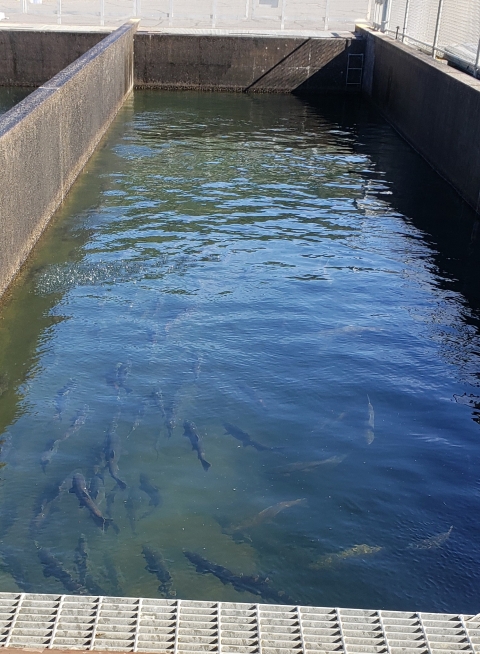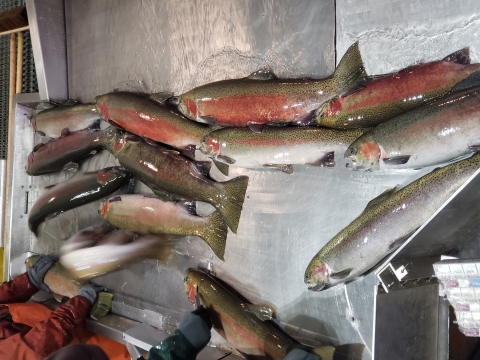Our Services
ALL YEAR...Our work never ends!
January
- The hatchery fish ladder is opened intermittently for B-run steelhead trout. Adult fish are kept in outside holding ponds temporarily until they are spawned. Steelhead smolts are in outside Burrows ponds as they only have a couple months left on the hatchery before they are released to start their 800 mile journey to the ocean.
- Chinook smolts are in the 30 raceways toward the west end of the hatchery and are also in the final stretch of their time here before being released in March to start their downstream journey to the ocean.
- Steelhead spawning begins in January. Spawning occurs intermittently during the month depending on when the fish are ready to be spawned. This varies somewhat from year to year depending on the water temperatures that they have been exposed to over the past few months. Spawning starts at approximately 8am and typically occurs on Tuesdays, and may continue to early afternoon depending on the number of fish that are spawned on that day. Visitors may watch the process from the viewing balcony in the main hatchery building. Volunteers are on hand to answer questions for scheduled tours.
- Year-old steelhead and salmon are PIT-tagged prior to their release in April. Idaho Fish and Wildlife Conservation office conducts river surveys and off-site PIT tag operations on Chinook salmon smolts.
- School and group tours are at their peak in the spring due to weekly steelhead trout spawning.
- The Hatchery is closed to the public on New Year’s Day, but will be open to the public on Martin Luther King, Jr. Day.
February
- Steelhead spawning will occur intermittently during the month of February continues through the end of April. Spawning begins at approximately 8am and typically occurs on Tuesdays and may continue to early afternoon. Visitors may watch the process from the viewing balcony in the main hatchery building. Volunteers are on hand to answer questions for scheduled tours.
- Coho pre-smolts are moved to Kooskia National Fish Hatchery for acclimation and conditioning prior to direct release into Clear Creek.
- Staff from the Pacific Region Fish Health Department begin pre-release health surveys on the steelhead smolts, Chinook smolts and Coho pre-smolts at the hatchery.
- School and group tours are at their peak in the spring which coincides with the peak of steelhead trout spawning.
- The hatchery is open to the public on President's Day.
March
- Steelhead spawning continues each Tuesday, beginning at approximately 8am. Visitors may watch the process from the viewing balcony in the main hatchery building. The majority of the steelhead spawning occurs in March and additional eggs are collected to support our partners with the Idaho Fish and Game as eggs are transferred to the Clearwater State Fish Hatchery located just across the North Fork River and the Magic Valley State Fish Hatchery also receives eggs spawned at Dworshak. Volunteers are on hand to answer questions for scheduled tours.
- Eggs from February spawning dates are beginning to hatch in the nursery.
- Release of 280,000 Coho from the Kooskia National Fish Hatchery into Clear Creek occurs.
- 1,050,000 Spring Chinook Salmon smolts are released directly into the North Fork Clearwater River to start their 800 mile journey to the Pacific Ocean.
- School and group tours are at their peak in the spring due to weekly steelhead trout spawning. Reservations should be made in advance (a couple weeks is preferred).
April
- Steelhead spawning continues intermittently through the end of the month to ensure that the eggs collected represent the later part of the run. Visitors may watch the process from the viewing balcony in the main hatchery building. Volunteers are on hand to answer questions for scheduled tours.
- Steelhead fry are hatching and feeding in the nursery.
- Nearly 2.1 million steelhead smolts are released into the Clearwater River from the hatchery and at off-site release locations to begin their 800 mile journey to the Pacific Ocean.
- Chinook Salmon fry are moved outside into the raceways from either incubation stacks or from nursery rearing tanks.
- Steelhead trout sportfishing season closes this month; The Idaho Department of Fish and Game has up-to-date regulations posted on their site.
May
- The hatchery fish ladder is closed and cleaned out at the completion of steelhead spawning, and all outside ponds are cleaned and disinfected following smolt releases.
- Steelhead fry are hatching and feeding in the nursery.
- The first of the young steelhead spawned back in January are reaching a size where they are beginning to be moved outside from the nursery in May. These fish have their adipose fin removed to identify them as a hatchery reared fish. The fish may also receive a coded wire tag at this time. The tags are valuable in providing information after they are released approximately 1 year later.
- Coho salmon are trucked from Kooskia to Dworshak at 2-3 inches where they will be reared until next February and then returned to Kooskia for acclimation and release into Clear Creek.
- Kid's Fishing Day is held in Apri/May of every year!
- The Hatchery is open to the public on Memorial Day.
June
- The fish ladder is opened for returning adult Spring Chinook salmon.
- As the young steelhead continue to outgrow the indoor nursery tanks, they are moved to the outside burrows ponds throughout the month. The fish are run through the marking trailer and the adipose fin is clipped. The fish may also receive a coded wire tag.
July
- Adult Chinook salmon continue to return to Dworshak and Kooskia hatcheries. Kooskia salmon are trucked to Dworshak, held in the large holding ponds until to spawning occurs in August.
- Steelhead fingerlings have adipose fins clipped in the marking trailers, and are moved to outside Burrows ponds. They remain here until they are released the following April. Visitors are welcome to tour the marking trailers at either Kooskia NFH or Dworshak FH. Displays explaining the various forms of fish marking are available to view in the Visitor Center upstairs lobby.
- Steelhead numbers in each burrows pond are reduced by moving a portion of the fish in each pond to other ponds. This decreases the crowding as the fish grow larger which is done to maximize the overall quality of the fish during their time at the hatchery. They still have another 8 months of rearing before they are released.
- Dworshak Reservoir begins a drawdown of water to aid salmon migration to the ocean. Cold water is released from the dam, cooling the Snake River enough that salmon smolts can survive. Idaho Fish and Wildlife Conservation Office conducts field surveys of salmon smolt migration in tributaries of the Clearwater River.
- Hatchery fish have their adipose fins clipped in the marking trailers; visitors are welcome to tour the marking trailers at either Kooskia NFH or Dworshak NFH. Displays explaining the various forms of fish marking are available to view in the Visitor Center upstairs lobby.
- The Hatchery is open to the public on the 4th of July.
August
- Spring Chinook salmon spawning begins approximately the second Tuesday in August at around 8am, and continues each Tuesday for 4-5 weeks until the egg collection target is met. Visitors may watch the process from the viewing balcony in the main hatchery building.
- Additional Steelhead fingerlings have adipose fins clipped and are moved to outside Burrows ponds. As the youngest steelhead are moved outside of the nursery into the burrows ponds, steelhead numbers in each burrows pond from the fish that we spawned earliest are continuously being moved to other ponds to decrease the crowding as the fish grow larger. This is done to maximize the overall quality of the fish during their time at the hatchery. They still have another 7 months of rearing before they are released.
- Spring Chinook salmon, nearly one year old, begin having adipose fins clipped. These fish are moved from raceways, through the marking trailer, and back into the raceways at lower densities where they will remain until release next spring.
September
- Spring Chinook salmon spawning take place each Tuesday, beginning around 8am, until approximately the second week of September if needed. Visitors may watch the process from the viewing balcony in the main hatchery building.
- The Spring Chinook salmon eggs are incubated on chilled water to slow down development and hatching. This is done to align with hatchery operations and to improve fish quality by aligning hatching, feeding and release with appropriate target sizes and better fish cultural practices.
- The fish ladders at Dworshak and Kooskia are closed and cleaned following spawning, in preparation for receiving early-return steelhead trout.
- The Clearwater County Fair and Lumberjack Days in Orofino is held the 3rd weekend in September. Dworshak Fisheries Complex staffs an exhibit with activities for kids throughout the fair weekend. In the booth, displays provide an overview of the hatchery, fish health and fishery management activities.
- All year-old spring Chinook salmon smolts are adipose fin-clipped. .
October
- The fish ladder is open for early-return adult steelhead trout. The ladder will be closed following the collection of 500 adult steelhead. This may occur any time between early October and mid-December, depending on the return. It is important to incorporate these early returning steelhead into the spawning and rearing effort as they early returning fish provide for future progeny that will return early in the fall. This provides increased angler opportunities for sport and tribal anglers. Steelhead will be held into the winter, and spawned beginning in January.
- Early-return adult steelhead are sorted by biologists at Dworshak FH.
- The ladder at Kooskia is operated to collect Coho salmon and spawning occurs in October and November. The eggs are incubated and early rearing occurs at the Kooskia hatchery. These fish will be transferred to the Dworshak Hatchery next May.
- Eyed eggs from adult spring Chinook salmon trapped at Kooskia NFH are transported back to Kooskia for hatching, rearing and release after 18 months.
- Steelhead fishing season in the Clearwater River opens mid-month; check regulations at Idaho Department of Fish and Game's website.
- The Hatchery is open to the public on Columbus Day.
November
- Spring Chinook salmon eyed eggs continue to be transported to Kooskia NFH.
- The Hatchery is open to the public on Veteran's Day, but will be closed on Thanksgiving Day.
December
- Coho eggs are beginning to "eye-up", meaning you can start to see the eyes of the fish within the egg.
- The fish ladder is closed by mid-December, after about 500 early-return adult steelhead trout have returned to the hatchery. The ladder will re-open in January to represent the middle portion of the steelhead run.
- Chinook salmon fry (young fish) are hatching and are moved to tanks in the nursery to continue growing and begin feeding.
- Hatchery is closed to the public on Christmas day.



